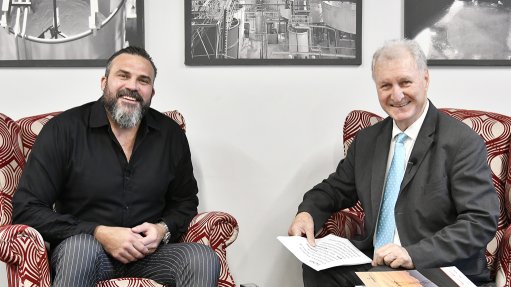Global wind installation step change required to meet net-zero goal
Despite Covid-afflicted 2020 emerging as the best-ever year for global wind-energy installations, a new industry report argues that the rate of yearly deployments will have to more than double before the end of the current decade if onshore and offshore wind generators are to make their rightful contribution to restricting the rise in the average global temperature to no more than 1.5 °C above pre-industrial levels.
The Global Wind Energy Council’s (GWEC’s) newly released ‘Global Wind Report 2021’ shows that installations increased by 53% to 93 GW last year when compared with 2019.
A total of 86.9 GW of onshore capacity was installed, while 6.1 GW of offshore capacity was commissioned during the year, increasing the global cumulative wind power capacity to 743 GW.
China and the US installed 74% of all new onshore wind power in 2020, while China alone installed half of the offshore wind added last year. South Africa added 515 MW in 2020, increasing its total wind installations to 2 465 MW.
Nevertheless, GWEC’s analysis on the role that wind power will need to play in meeting the ‘net zero’ carbon pledges being made by a growing number of large economies and corporations points to the need for a step change in the pace of installations before 2030 to create a credible basis for meeting the target by 2050.
Speaking during the virtual release of the report, CEO Ben Backwell said that the world would need to be installing around 180 GW a year “to get to where we need to be”.
“Every year we fall short, the mountain to climb gets higher,” he warned.
GWEC Market Intelligence expects that over 469 GW of new onshore and offshore wind capacity will be added in the next five years, translating to yearly installations of about 94 GW – well short of the run rates required in net-zero scenarios released by both the International Energy Agency (IEA), as well as the International Renewable Energy Agency (Irena).
Under the IEA’s ‘Net Zero by 2050’ scenario, yearly installation rates for wind would need to reach 160 GW by 2025 and 280 GW by 2030. In its World Energy Transitions Outlook, meanwhile, Irena states that electricity generation would need to expand three-fold by 2050, with renewables, including wind energy, providing 90% of the total supply.
In presenting the report, GWEC head of policy and project Joyce Lee described the current decade as “make or break” for meeting the targets set in Paris, with fresh climate negotiations set to take place in Glasgow, Scotland, in November, where Paris signatories will commit to new Nationally Determined Contributions for mitigating and adapting to climate change.
She said a “climate-emergency approach” to policymaking was needed to accelerate the pace of wind installations, as well as the other technologies and solutions required to meet the net-zero target, such a solar, green hydrogen, powerfuels, electric vehicles, biofuels, energy efficiency and smart grids.
GWEC also called for greater collaboration across the energy sector, including with the oil and gas industry, which was on an “irreversible transition to clean energy”.
Some oil and gas companies, it argued, had the know-how, technology, project and finance experience that could complement the need for an accelerated deployment of renewable energy.
Also speaking during the webinar, South African Wind Energy Association CEO Ntombifuthi Ntuli presented an optimistic picture for the domestic wind sector, which she said was entering an exciting new phase following a sustained period of policy uncertainty.
Some 14 000 MW of onshore wind could be added to the South African electricity mix by 2030, with a request for proposals for the first 1 600 MW of that having been released to the market in mid-March.
Growth would be driven, Ntuli said, by coal plant decommissions, with more than 11 000 MW of old coal capacity scheduled to be shut by 2030 and about 24 000 MW more by 2040.
Article Enquiry
Email Article
Save Article
Feedback
To advertise email advertising@creamermedia.co.za or click here
Comments
Press Office
Announcements
What's On
Subscribe to improve your user experience...
Option 1 (equivalent of R125 a month):
Receive a weekly copy of Creamer Media's Engineering News & Mining Weekly magazine
(print copy for those in South Africa and e-magazine for those outside of South Africa)
Receive daily email newsletters
Access to full search results
Access archive of magazine back copies
Access to Projects in Progress
Access to ONE Research Report of your choice in PDF format
Option 2 (equivalent of R375 a month):
All benefits from Option 1
PLUS
Access to Creamer Media's Research Channel Africa for ALL Research Reports, in PDF format, on various industrial and mining sectors
including Electricity; Water; Energy Transition; Hydrogen; Roads, Rail and Ports; Coal; Gold; Platinum; Battery Metals; etc.
Already a subscriber?
Forgotten your password?
Receive weekly copy of Creamer Media's Engineering News & Mining Weekly magazine (print copy for those in South Africa and e-magazine for those outside of South Africa)
➕
Recieve daily email newsletters
➕
Access to full search results
➕
Access archive of magazine back copies
➕
Access to Projects in Progress
➕
Access to ONE Research Report of your choice in PDF format
RESEARCH CHANNEL AFRICA
R4500 (equivalent of R375 a month)
SUBSCRIBEAll benefits from Option 1
➕
Access to Creamer Media's Research Channel Africa for ALL Research Reports on various industrial and mining sectors, in PDF format, including on:
Electricity
➕
Water
➕
Energy Transition
➕
Hydrogen
➕
Roads, Rail and Ports
➕
Coal
➕
Gold
➕
Platinum
➕
Battery Metals
➕
etc.
Receive all benefits from Option 1 or Option 2 delivered to numerous people at your company
➕
Multiple User names and Passwords for simultaneous log-ins
➕
Intranet integration access to all in your organisation





















